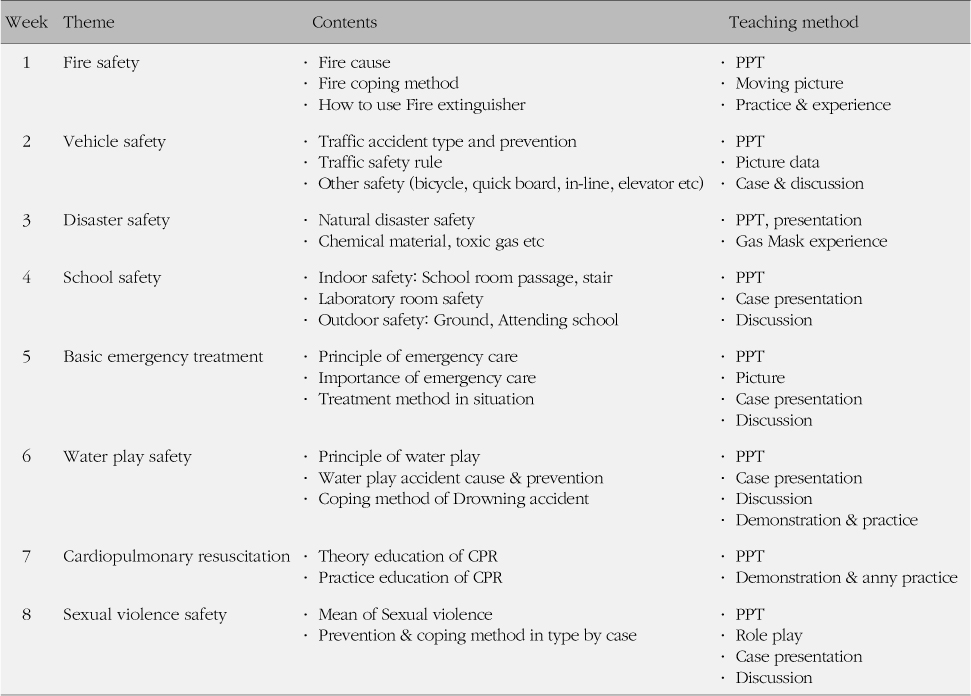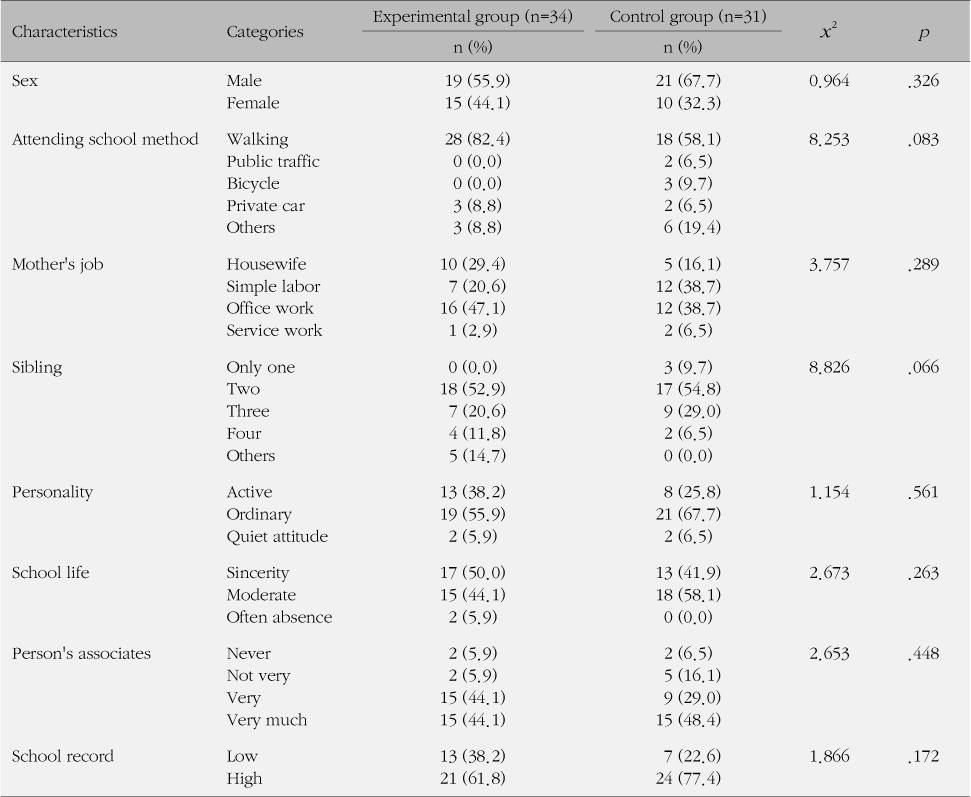Articles
- Page Path
- HOME > J Korean Acad Community Health Nurs > Volume 21(2); 2010 > Article
-
Original Article
- The Effects of a Safety Management Program on Safety Accident-related Knowledge, Attitude and Behavior of Elementary School Students in Korea
- Kyung Min Park, Kyoung Mi Jeon, Min Young Kim, Eun Suk Lee, Sang Min Kwon
-
Journal of Korean Academy of Community Health Nursing 2014;21(2):220-228.
DOI: https://doi.org/10.12799/jkachn.2010.21.2.220
Published online: April 4, 2014
1Professor, College of Nursing, Keimyung University, Korea.
2Full-time Lecturer, Department of Health Service Management, Kyungwoon University, Korea.
3Department of Nursing science, Taekyeung, Korea.
4Emergency Medical Technician 119 Rescue Squad, Korea.
5Part-time Instructor, Department of Health Service Management, Kyungwoon University, Korea.
• Received: May 17, 2010 • Revised: June 21, 2010 • Accepted: June 21, 2010
© 2010 Korean Academy of Community Health Nursing
This is an Open Access article distributed under the terms of the Creative Commons Attribution Non-Commercial License (http://creativecommons.org/licenses/by-nc/3.0/) which permits unrestricted non-commercial use, distribution, and reproduction in any medium, provided the original work is properly cited.
- 704 Views
- 9 Download
- 6 Crossref
Abstract
-
Purpose
- The purpose of this research was to determine the effects of a safety management program on safety accident-related knowledge, attitude and behavior of elementary school students in Korea.
-
Methods
- This study adopted nonequivalent control group pretest-posttest design. The number of subjects was 34 in the experimental group and 31 in the control group. The safety management program was performed for approximately 50 minutes each session, once a week for 8 weeks. Data were collected from March 14th to June 23th, 2006, and analyzed by χ2 test and independent t-test with SPSS WIN 16.0.
-
Results
- There were statistically significant differences in safety-related knowledge (t=3.010, p=.006) and behavior (t=18.833, p=.001) between the experimental group and the control group. The score of attitude was different between the experimental group and the control group but the difference was not statistically significant.
-
Conclusion
- The safety management program used in this study was appropriate for elemental school students and affected safety-related knowledge and behavior of elementary school students. Therefore safety education should be provided systematically for elementary schools over the whole country.
- 1. Consumer Safety Center. School status and the prevention of child safety Consumer Safety Center; 2006;Retrieved March, 10, 2006. from http://www.ciss.or.kr
- 2. Guyer B, Gallagher SS, Chang BH, Azzara CV, Cupples LA, Colton T. Prevention of childhood injures: Evaluation of the Statewide Childhood Injury Prevention Program (SCIPP). Am J Public Health. 1989;79(11):1521–1527. ArticlePubMedPMC
- 3. Hadan Elementary School. Safety of the school community through a variety of activities forming habits. Busan: Ministry of Education, Science and Technology; 2002.
- 4. Hall-Long BA, Schell K, Corrigan V. Youth safety education and injury prevention program. Pediatr Nurs. 2001;27(2):141–146. PubMed
- 5. Han GY. The effects of the parent education using educational letters on mother's rearing attitude. Seoul: Chung-Ang University; 2002. Unpublished master's thesis.
- 6. Jeon CO. A study on school accidents in elementary school. Cheongwon: Korea National University of Education; 1997. Unpublished master's thesis.
- 7. Jung MA. Effects of school safety education on the safety behavior among elementary school students in Korea. Daegu: Keimyung University; 2000. Unpublished master's thesis.
- 8. Jung MA. The effects of safety education program applied to elementary school students. Daegu: Kyungpook National University; 2004. Unpublished doctoral dissertation.
- 9. Kim SJ, Lee JE. A clinical study of accidental pediatric patients. Korean J Child Health Nurs. 1997;3(2):131–141.
- 10. Kim SJ, Yang SO, Jeong GH, Lee SH. Level of health promotion behavior practice in elementary school students. J Korean Acad Child Health Nurs. 2007;13(4):407–415.
- 11. Korea National Statistical Office. The cause of death statistics 2005;Retrieved September, 18, 2006. from http://www.kostat.go.kr
- 12. Korea Occupational Safety and Health Agency. A safety training course with - elementary school safety education program 2003;Retrieved June, 29, 2005. from http://www.kosha.or.kr
- 13. Lee JN, Jung MM, Park JW. Effects of school safety education on safety behavior among elementary school students. J Korean Acad Child Health Nurs. 2006;12(4):506–513.
- 14. Lim SJ, Lee MS. A comparative study of knowledge, attitude, and practice by before-after traffic safety education: Focusing on the 4th grade student in elementary school. J Korean Soc Health Educ Promot. 1999;16(1):31–43.
- 15. Ministry of Education Resources Development. Mutual status of school safety incident 2005;Retrieved September, 22, 2005. from http://www.mest.go.kr
- 16. Rivara FP, Calonge N, Thompson RS. Population-based study of unintentional injury incidence and impact during childhood. Am J Public Health. 1989;79(8):990–994. ArticlePubMedPMC
- 17. Russell KM, Champion VL. Health belief and social influence in home safety practices of mothers with preschool children. J Nurs Scholarsh. 1996;28(1):59–64.
- 18. Scheidt PC. Behavioral research toward prevention of childhood injury. Am J Dis Child. 1988;142:612–617. ArticlePubMed
- 19. Sewell KH, Gains SK. A developmental approach to child hood safety education. Pediatr Nurs. 1993;19(5):464–466. PubMed
- 20. Sim ES. Safety-awareness, safety-practice and accident occurrence among elementary students. Seoul: Yonsei University; 2003. Unpublished master's thesis.
- 21. Yoon SH. Analysis of child safety policies for child injury death factors. Seoul: Sookmyung Women's University; 2003. Unpublished doctoral dissertation.
Figure & Data
References
Citations
Citations to this article as recorded by 

- ORTAOKUL ÖĞRENCİLERİNİN ÖZ YETERLİLİK DÜZEYİ İLE ACİL DURUMLARLA BAŞA ÇIKMA DURUMLARI ARASINDAKİ İLİŞKİ
Atiye KARAKUL, Duygu SÖNMEZ DÜZKAYA, Aybüke TANRIVERDİ
Izmir Democracy University Health Sciences Journal.2022; 5(3): 707. CrossRef - Attitudes, Perception and Preventive Behaviors for Health and Safety among College Students
Hwa Jeong Seo
Korean Journal of Health Promotion.2018; 18(4): 169. CrossRef - Effects of Safety Awareness and Self-Efficacy on Safety Practice with Elementary School Studentsts: Focusing on the Changwon City
Sin-Young PARK, Yong-Sook EO
Journal of Fisheries and Marine Sciences Education.2016; 28(2): 515. CrossRef - A Study of Effect of Disability Prevention Program Acquired by People with Disabilities are Performed : centered on Elementary School Students
Yeon-Jung Kim
Journal of Digital Convergence.2016; 14(5): 369. CrossRef - Factors associated with Unintentional Injuries to Korean Adolescents at School: A Multilevel Study
Jung-Ok Yu, Myo-Sung Kim
Journal of Korean Academy of Community Health Nursing.2016; 27(4): 337. CrossRef - A Systematic Review on the Evaluation of School based Unintentional Injuries Prevention Programmes in 7~19 Years Old
Geum Hee Kim, Hyeong Sik Ahn, Hyeon Jeong Kim, Mi Lan Han
Journal of the Korean Society of School Health.2014; 27(1): 7. CrossRef

 KACHN
KACHN




 PubReader
PubReader Cite
Cite

